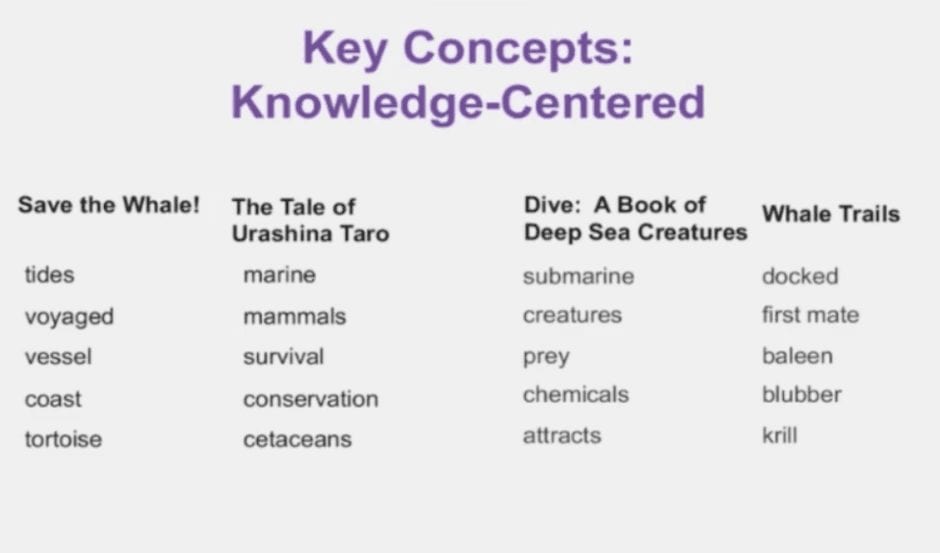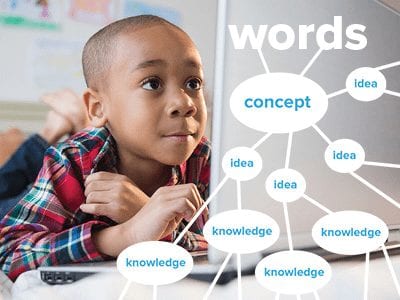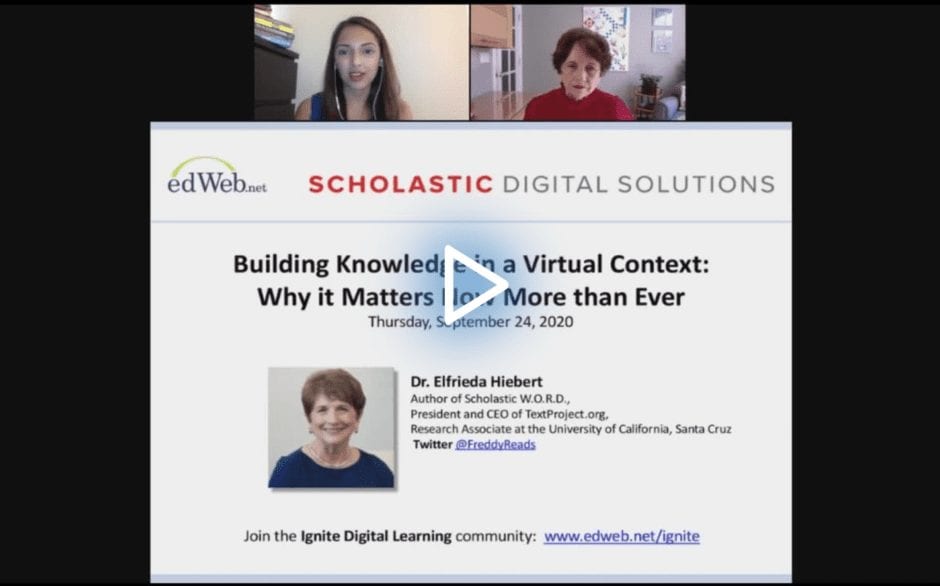Teaching Vocabulary in the Service of Knowledge
By Michele Israel
What exactly is in a word? Perhaps more than we realize. A well-stocked vocabulary is what helps students make sense of what they read. That comprehension builds their overall understanding of the world around them.
Strengthening students’ grasp of language and knowledge takes more than merely learning a weekly list of core words, contended Dr. Elfrieda “Freddy” Hiebert, Author of Scholastic W.O.R.D., in a recent edWebinar sponsored by Scholastic Digital Solutions, exploring a more strategic approach to vocabulary acquisition.
So Many Words to Know
There are many words that students might learn. Still, traditionally, they are required to learn a set of core words, which often appear to be randomly selected and are not connected thematically. The result is a limited foundational vocabulary that deters readers from the contextual richness of texts learners read.
Dr. Hiebert argued that students must be able to do more than decode words: They must be able to understand and link vocabulary contextually in what they read and give meaning to other words.
Her extensive vocabulary research (she admits she’s a word “geek”) got her wondering why certain words are chosen to teach and which words should actually be taught. In her examination of books (she even developed a word zone analyzer), Dr. Hiebert identified word distribution in texts.
She framed her analysis around 12 variables highlighting what influences learner acquisition and memory of a word in reading. And more specifically, what enables them to give the word meaning in the context of the sentence that’s being used (beyond just being able to say the word).
Dr. Hiebert discovered that words selected to be taught are not the more frequent words in written language. She found, for example, that 2,500 families of words accounted for a little more than 90% of the words in all texts, from first grade through college and career ready. Another band of about 2,500 words occurs at least 10 times per million words of text. (These tend to be rare or unique words that find their way onto required vocabulary lists.)
With so many words, Dr. Hiebert wondered: Why in a reading program would certain words be chosen for instruction? Are there some words that matter more in English than other words? Could there be a parsimonious core vocabulary? Might we do more, she reflected, than just saying, “Well, that looks like a good word [to teach]”?

How to Teach Critical Vocabulary Strategically
“The thing to keep remembering is that these just aren’t words that are hanging out there by themselves,” emphasized Dr. Hiebert. “We don’t learn words as you might think of as a file cabinet; we learn words in relation to other words.”
The same words have different contextual meanings and uses (get in shape vs. shape as in triangle, for example). Words vary morphologically, orthographically, and semantically. Some word families have more words than others.
People learn words best in a connected manner, explained Dr. Hiebert, adding that teaching vocabulary through topical clusters goes hand in hand with supporting learners’ understanding of their physical and social worlds.
Words should be taught in the service of knowledge: Learners build their vocabulary and knowledge through knowledge-centered text. To do this, she advised clustering English language arts reading around informational and narrative texts that share topics.
“Knowing something about topics and how vocabulary works is going to be better than having a diffuse curriculum,” said Dr. Hiebert.
But repeated core vocabulary, with a focus on the 2,500 more frequent morphological families across texts (particularly for beginning and struggling readers), reinforces learners’ grasp of words and their contextual changes. This approach helps students acquire a richer bank of words while developing knowledge. They are also engaged in a deeper level of reading that adds more complex words to their vocabulary.
Where to Start?
If the knowledge-based approach to reading instruction is new to you, fret not. There are tools and strategies available to jumpstart its implementation in your classroom.
TextProject, an open educational resource, provides numerous research-based K-6 resources (including intentional texts that have a greater number of core words drawn from 2,500 morphological families) that drive this targeted approach to reading instruction.
Scholastic W.O.R.D. (a subscription-based K-5 literacy program) facilitates vocabulary acquisition and deepens reading comprehension by teaching new words in context across theme-based content areas.
This edWeb broadcast was sponsored by Scholastic Digital Solutions.
This article was modified and published by eSchool News.
About the Presenter
Dr. Elfrieda “Freddy” Hiebert is a vocabulary acquisition expert, renowned researcher, and author of Scholastic W.O.R.D. She has had a lifelong career as a literacy educator and has scanned and studied 10,000 children’s texts to discover the 2,500 morphological word families students will encounter 90% of the time. She is the president and CEO of TextProject.org and is a research associate at the University of California, Santa Cruz. She is a fellow of the American Research Association and was awarded a William S. Gray Citation of Merit by the International Reading Association for outstanding contributions to the field of reading.
Join the Community
Ignite Digital Learning is a free professional learning community on edWeb.net where educators, librarians, and administrators can explore strategies and tactics for getting every child to be a better thinker, better reader, and better writer through the use of digital resources.
Scholastic Education’s digital solutions help educators impact their students’ literacy achievement where it’s needed most. Through access to 1000s of high-quality ebooks and research-based digital literacy tools, their child-centric digital products develop students’ literacy skills leading to fluent readers for life.
Michele Israel writes about the ideas and best practices that are shared in edWeb’s edWebinars so they can spread innovative and best practices to the education community. Michele owns Michele Israel Consulting, LLC, which serves large and small educational, nonprofit, media, corporate, eLearning, and blended-learning organizations to bolster products and programs. Her rich career spans over 25 years of successfully developing educational materials and resources, designing and facilitating training, generating communication materials and grant proposals, and assisting in organizational and program development. In addition to lesson plans and other teacher resources, Michele’s portfolio includes published articles covering a range of educational and business topics.




Comments are closed.